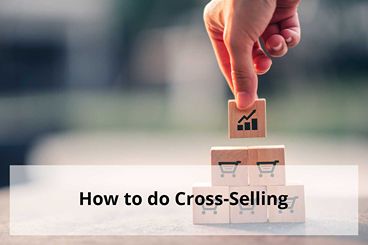Want to learn how to do cross-selling? You are not alone. Cross-selling is a great way for salespeople to generate additional revenue and gain new customers. However, it can be difficult to master. The products section of your storefront is where all the sales magic happens and is an essential component to selling successfully. By combining promotions and placement, it’s how sellers drive up conversion rates and increase their overall sales per customer.
In this article, you will learn how to do cross-selling, how to prevent objections when performing cross-selling, and how to pick the right opportunities for cross-selling products.
What is Cross-Selling?
Cross-selling can be a great way to turn a single sale into multiple sales, or even a new customer into a repeat customer.
Cross-Selling can be defined as the recommendation of additional products or services to existing customers that would help them complete a task. To cross-sell, any business needs to identify the needs, desires, and interests of their existing customers to discover ways they might be assisted by other products or services. An example would be a customer buying a new handbag, and the salesperson recommends she buys a care kit, purse insert, coin purse, or wallet to go with it.
What are the Benefits of Cross-Selling?
If executed properly, cross-selling can help increase sales volume and revenue while building stronger relationships with your customers. Cross-selling may also lead to cost savings, which could be achieved by coordinating activities across different departments or business units. Some benefits include:
- Profit growth: By selling additional products and services to existing customers, companies can generate more revenue without having to spend as much on marketing and advertising efforts.
- Improved customer relationships: Customers who buy multiple products from a company are more likely to be loyal and less likely to leave when they find a better deal elsewhere. They may also refer others in their network because they have had positive experiences with your company before.
- Increased Average Order Value: One of the most important benefits of cross-selling is that it increases your average order value. If you can increase the average order value by just $5 across all your customers, this can double your profits. This is because the cost of acquiring an additional customer is much more expensive than upselling an existing one.
- Reduced Acquisition Costs: Acquiring new customers is one of the most expensive things a business does. By cross-selling to existing customers instead of trying to acquire new ones, you can reduce these costs and maximize your profits.
- Increased Conversion Rate: Another benefit is that it increases your conversion rate by improving how many people actually buy from you.
How to do Cross-Selling Correctly
Cross-selling is a marketing term for the practice of suggesting related products or services to a customer who is considering purchasing something. Your goal to cross-sell is to get more customers to buy more items.
Here are some proven ways to do cross-selling correctly:
- Make sure you’re selling the right product.
- Know your buyer.
- Add value by educating.
- Offer complementary products.
- Use cross-selling software.
Are There Any Cons to Cross-Selling?
There are a few disadvantages of cross-selling.
- One is that it can be difficult to get started. You need to have the right tools in place and know what your customers want.
- Another disadvantage is that it can be hard to do in person or over the phone, but you have more flexibility online where you can see what products your customer has bought and make suggestions based on that.
What Kinds of Businesses Would Benefit from Cross-Selling?
When it comes to cross-sell, the sky’s the limit. Any business that has two or more products or services that are related to each other in some way can benefit from cross-selling.
Do you have a product line? Cross-sell! Do you have a service line? Cross-sell! Do you have both? We have great news for you: you can cross-sell both!
Cross-selling is an excellent way to increase your average transaction size and boost revenue, but it’s also a great way to demonstrate your expertise and build customer trust. Customers love having their needs met by experts who know what they’re talking about, and they love feeling like they’ve gotten good value for their dollar. When you cross-sell, you give them both of those things and that keeps them coming back for more!
What Should You Avoid Doing When Cross-Selling?
When cross-selling, there are a few things you should avoid doing.
First, don’t try to sell your customers something they don’t need. If you’re trying to convince a customer that they need a new printer when their old one is in fine condition, you’re just going to annoy them.
Second, don’t be pushy! If your customer has explicitly said that they do not want another product, and you keep trying to sell it to them anyway, they will not have a pleasant experience with your company.
Finally, try not to get too personal with the customer. They may or may not want to share details about their life with you, so if you’re asking questions that are too personal or that could make the customer uncomfortable, stop right there!
Final Thoughts on How to do Cross-Selling
Cross-selling is a crucial skill in sales. The ability to keep what you’ve already sold in the back of your mind while selling something else is key. It’s not just about what you sell, it’s also about how you sell it. Your tone matters, your approach to customer service matters, and being responsive to your customers’ needs matters. You can do cross-selling in person, over the phone, in email, on social media, and more. The more comfortable you are with it, the more successful you’ll be as a salesperson.
Now that you’ve mastered cross-selling, there’s only one thing left to do, leave it to the pros at LOOP to handle your cross-selling needs!













